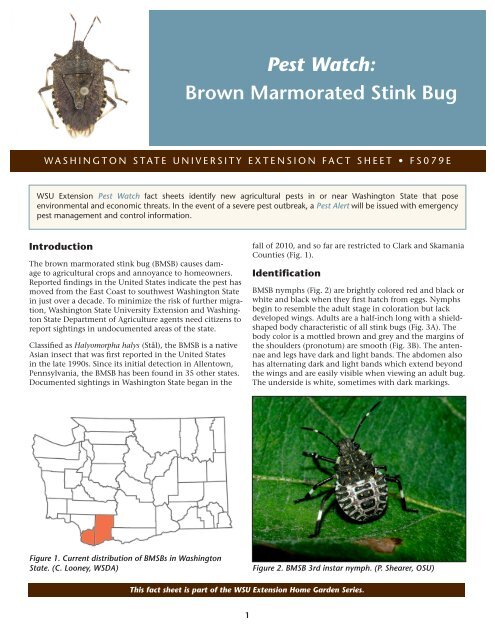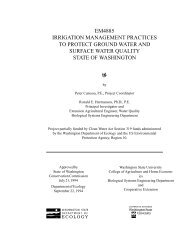Pest Watch: Brown Marmorated Stink Bug - Washington State ...
Pest Watch: Brown Marmorated Stink Bug - Washington State ...
Pest Watch: Brown Marmorated Stink Bug - Washington State ...
You also want an ePaper? Increase the reach of your titles
YUMPU automatically turns print PDFs into web optimized ePapers that Google loves.
1<br />
<strong>Pest</strong> <strong>Watch</strong>:<br />
<strong>Brown</strong> <strong>Marmorated</strong> <strong>Stink</strong> <strong>Bug</strong><br />
WASHINGTON STATE UNIVERSITY EXTENSION FACT SHEET • FS079E<br />
WSU Extension <strong>Pest</strong> <strong>Watch</strong> fact sheets identify new agricultural pests in or near <strong>Washington</strong> <strong>State</strong> that pose<br />
environmental and economic threats. In the event of a severe pest outbreak, a <strong>Pest</strong> Alert will be issued with emergency<br />
pest management and control information.<br />
Introduction<br />
The brown marmorated stink bug (BMSB) causes damage<br />
to agricultural crops and annoyance to homeowners.<br />
Reported findings in the United <strong>State</strong>s indicate the pest has<br />
moved from the East Coast to southwest <strong>Washington</strong> <strong>State</strong><br />
in just over a decade. To minimize the risk of further migration,<br />
<strong>Washington</strong> <strong>State</strong> University Extension and <strong>Washington</strong><br />
<strong>State</strong> Department of Agriculture agents need citizens to<br />
report sightings in undocumented areas of the state.<br />
Classified as Halyomorpha halys (Stål), the BMSB is a native<br />
Asian insect that was first reported in the United <strong>State</strong>s<br />
in the late 1990s. Since its initial detection in Allentown,<br />
Pennsylvania, the BMSB has been found in 35 other states.<br />
Documented sightings in <strong>Washington</strong> <strong>State</strong> began in the<br />
fall of 2010, and so far are restricted to Clark and Skamania<br />
Counties (Fig. 1).<br />
Identification<br />
BMSB nymphs (Fig. 2) are brightly colored red and black or<br />
white and black when they first hatch from eggs. Nymphs<br />
begin to resemble the adult stage in coloration but lack<br />
developed wings. Adults are a half-inch long with a shieldshaped<br />
body characteristic of all stink bugs (Fig. 3A). The<br />
body color is a mottled brown and grey and the margins of<br />
the shoulders (pronotum) are smooth (Fig. 3B). The antennae<br />
and legs have dark and light bands. The abdomen also<br />
has alternating dark and light bands which extend beyond<br />
the wings and are easily visible when viewing an adult bug.<br />
The underside is white, sometimes with dark markings.<br />
Figure 1. Current distribution of BMSBs in <strong>Washington</strong><br />
<strong>State</strong>. (C. Looney, WSDA) Figure 2. BMSB 3rd instar nymph. (P. Shearer, OSU)<br />
This fact sheet is part of the WSU Extension Home Garden Series.
Other stink bugs and related Hemipterans (true bugs)<br />
already occurring in <strong>Washington</strong> may be confused with<br />
BMSBs. Similar-appearing stink bugs include Euschistus sp.<br />
(Fig. 4), Holcostethus sp. (Fig. 5), and Brochymena sp. (Fig. 6).<br />
BMSBs can be distinguished from other stink bugs by their<br />
mottled coloration in combination with light and dark<br />
banding on the antennae, legs, and abdomen (Fig. 3A).<br />
A B<br />
A B<br />
A B<br />
A B<br />
2<br />
Figure 3. BMSB adult. A)<br />
Note the light and dark<br />
bands on antennae, legs, and<br />
abdomen. B) The edges of<br />
the shoulders are smooth. (D.<br />
Kitchen, WSDA)<br />
Figure 4. A) Euschistus sp.<br />
adult without bands on<br />
antennae or legs. B) Note<br />
the toothed edges on the<br />
shoulders. (D. Kitchen, WSDA)<br />
Figure 5. A) Holcostethus sp.<br />
adult without light and dark<br />
bands on the antennae, legs,<br />
or abdomen. B) The edges of<br />
the shoulders are smooth. (D.<br />
Kitchen, WSDA)<br />
Figure 6. A) Brochymena<br />
sp. adult with light and dark<br />
bands on legs and abdomen.<br />
B) The edges of the shoulders<br />
are heavily toothed. (D.<br />
Kitchen, WSDA)<br />
Euschistus and Brochymena look strikingly like BMSBs<br />
except for the toothed edges on the shoulders (Figs. 4B<br />
and 6B, respectively). While Holcostethus can have smoothedged<br />
shoulders (Fig. 5B), they do not have banded legs<br />
or antennae (Fig. 5A). Other hibernating bugs commonly<br />
found in the home are western conifer seed bugs (Leptoglossus<br />
occidentalis, Fig. 7), grass bugs (Peritrechus sp., Fig. 8),
Figure 7. Leptoglossus occidentalis<br />
adult. (T. Murray, WSU)<br />
Figure 10. Lygaeus sp. adult. (T.<br />
Murray, WSU)<br />
boxelder bugs (Boisea, Fig. 9), milkweed bugs (Lygaeus,<br />
Fig. 10), and the seed bugs Rhyparochromis vulgaris (Fig. 11)<br />
and Raglius alboacuminatus (Fig. 12).<br />
Life Cycle<br />
Overwintering female BMSB adults emerge from protected<br />
areas such as buildings in early spring to lay eggs in clusters<br />
of 20 to 30 on the undersides of leaves (Fig. 13). Eggs begin<br />
hatching by early June. Nymphs go through five growth<br />
stages. Early instar nymphs tend to feed in aggregations<br />
but begin to disperse as they get older. Nymphs are highly<br />
mobile and are often seen walking from tree to tree. The<br />
next generation’s adults appear by August.<br />
Damage<br />
Figure 8. Arhyssus sp. adult. (E.<br />
LaGasa, WSDA)<br />
The BMSB has proven to be a significant pest in the eastern<br />
United <strong>State</strong>s, causing severe losses in apple yields. It feeds<br />
throughout its nymph and adult stages on a wide range of<br />
plants, including high-value agricultural crops such as tree<br />
fruit (Fig. 14), grapes, berries, vegetables, corn, soybeans, and<br />
ornamentals. BMSB feeding damage results in deformation<br />
and rotten blemishes on fruit and other plant parts (Fig. 15).<br />
As the name implies, BMSBs emit unpleasant odors. Beginning<br />
in September, BMSB adults aggregate in large masses<br />
often on the sides of homes and other buildings. They<br />
enter structures to avoid cold weather. While stink bugs are<br />
not known to harm people or cause damage to buildings,<br />
they can be quite distressing when large numbers of individuals<br />
enter households. Adult bugs may become active<br />
during warm periods of the winter, further causing annoy-<br />
Figure 11. Rhyparochromis vulgaris<br />
adult. (E. LaGasa, WSDA)<br />
3<br />
ance as they fly and crawl around inside houses and emit<br />
unpleasant odors. The overwintering behavior adds to the<br />
BMSB’s pest status as a nuisance to homeowners.<br />
Management<br />
The BMSB has shown high adaptability to different climates<br />
in the United <strong>State</strong>s and appears to resist commonly<br />
used pesticides. Farmers are resorting to using broadspectrum<br />
insecticides until better management techniques<br />
are developed. Entomologists are researching long-term<br />
management tools such as biological control. Small wasps<br />
have been found to effectively parasitize and kill BMSB<br />
eggs in the pest’s China homeland. However, further study<br />
is needed before these wasps are proven safe to release.<br />
In areas of the country where BMSB populations are high,<br />
homeowners have dealt with problems by sealing up their<br />
houses as tight as possible. Sealing cracks, mending screens,<br />
and screening vents mechanically exclude BMSB adults<br />
from entering houses. When aggregations begin to form,<br />
regular vacuuming BMSB adults has helped reduce the<br />
number entering houses.<br />
Sampling<br />
Figure 9. Boxelder bug, Boisea adult.<br />
(C. Hedstrom, OSU)<br />
Figure 12. Raglius alboacuminatus<br />
adult. (E. LaGasa, WSDA)<br />
It is likely that the BMSB will continue to spread, as this<br />
pest often hitchhikes on cars and cargo. Without any<br />
reliable survey methods identified as of yet, limiting the<br />
spread will rely on public detections of BMSBs in new locations.<br />
If you suspect you have BMSBs in a new region of<br />
<strong>Washington</strong> <strong>State</strong>, please collect a sample in a crush-proof<br />
container, note the date and specific location, and place it
Figure 13. BMSB eggs. (P. Shearer, OSU)<br />
Figure 14. BMSB adult on Asian pear. (P. Shearer, OSU)<br />
in a freezer until you can take it to your local WSU Extension<br />
office or local Master Gardener clinic (http://ext.wsu.<br />
edu/locations). Your observations will be recorded and help<br />
minimize the distribution of BMSBs statewide.<br />
Further Reading<br />
Bernon, G., K.M. Bernhard, A.L. Nielsen, J.F. Stimmel,<br />
E.R. Hoebeke, and M.E. Carter. 2007. Host Range of the<br />
Exotic <strong>Brown</strong> <strong>Marmorated</strong> <strong>Stink</strong> <strong>Bug</strong>, Halyomorpha halys<br />
(Hemiptera: Pentatomidae): Implications for Future<br />
Distribution. In Proceedings, 17th U.S. Department of<br />
Agriculture Interagency Research Forum on Gypsy Moth and<br />
Other Invasive Species, 200, edited by K.W. Gottschalk,<br />
26. Gen. Tech. Rep. NRS-P-10. Newtown Square, PA: U.S.<br />
Department of Agriculture. http://www.treesearch.fs.fed.<br />
us/pubs/12454.<br />
4<br />
Figure 15. BMSB feeding damage on apple. A) External<br />
blemish. B) Injury to underlying tissue. (P. Shearer, OSU)<br />
Department of Horticulture. <strong>Brown</strong> <strong>Marmorated</strong> <strong>Stink</strong> <strong>Bug</strong><br />
in Oregon. Oregon <strong>State</strong> University, http://horticulture.<br />
oregonstate.edu/group/brown-marmorated-stink-bugoregon.<br />
Hoebeke, E.R. and M.E. Carter. 2003. Halyomorpha halys<br />
(Stål) (Heteroptera: Pentatomidae): A Polyphagous Plant<br />
<strong>Pest</strong> from Asia Newly Detected in North America. In<br />
Proceedings of the Entomological Society of <strong>Washington</strong><br />
105(1): 225-237. http://www.biodiversitylibrary.org/<br />
pdf2/002249500054811.pdf.<br />
New Jersey Agricultural Experiment Station. How to Control<br />
the <strong>Brown</strong> <strong>Marmorated</strong> <strong>Stink</strong> <strong>Bug</strong>. Rutgers Cooperative<br />
Extension, http://njaes.rutgers.edu/stinkbug/<br />
control.asp.<br />
A<br />
B
By Todd Murray, Extension Educator, WSU Skamania County Extension; Chris Looney, <strong>Pest</strong> Biologist, <strong>Washington</strong> <strong>State</strong> Department of Agriculture;<br />
Eric LaGasa, Chief Entomologist, <strong>Washington</strong> <strong>State</strong> Department of Agriculture; and Peter Shearer, Professor of Entomology, Mid-Columbia Agricultural<br />
Research and Extension Center, Oregon <strong>State</strong> University.<br />
Copyright 2012 <strong>Washington</strong> <strong>State</strong> University<br />
WSU Extension bulletins contain material written and produced for public distribution. Alternate formats of our educational materials are available upon<br />
request for persons with disabilities. Please contact <strong>Washington</strong> <strong>State</strong> University Extension for more information.<br />
You may download copies of this and other publications from WSU Extension at http://pubs.wsu.edu.<br />
Issued by <strong>Washington</strong> <strong>State</strong> University Extension and the U.S. Department of Agriculture in furtherance of the Acts of May 8 and June 30, 1914. Extension<br />
programs and policies are consistent with federal and state laws and regulations on nondiscrimination regarding race, sex, religion, age, color, creed, and<br />
national or ethnic origin; physical, mental, or sensory disability; marital status or sexual orientation; and status as a Vietnam-era or disabled veteran. Evidence<br />
of noncompliance may be reported through your local WSU Extension office. Trade names have been used to simplify information; no endorsement is<br />
intended. Published September 2012.<br />
5<br />
FS079E

















